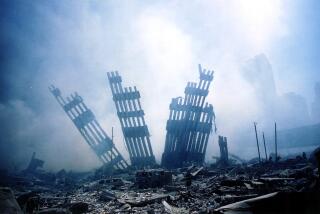Al Qaeda Mystery Man Described in Documents
- Share via
WASHINGTON — When Mohamedou Ould Slahi’s name appeared on the list released last week of Guantanamo Bay detainees, the Pentagon was officially confirming that one of Al Qaeda’s most mysterious figures had been in custody since late 2001.
And recently declassified documents show that Slahi has been talking to interrogators the whole time.
But the documents also show that the puzzle of a man U.S. terrorism experts believe was involved in the Sept. 11 attacks and the millennium plot to bomb Los Angeles International Airport seems only to grow deeper.
Slahi has maintained his innocence and said he’s such a valuable intelligence asset that his captors should set him free to live in the United States -- with the government providing security.
“Slahi was always a mystery man within the Al Qaeda hierarchy,” said Roger W. Cressey, a senior White House counter-terrorism official from 1999 to 2001 who investigated Al Qaeda plots.
“We could never prove he was the one who activated the Montreal [millennium] cell, but he had enough ties and relationship and dealings with known Al Qaeda operatives that would lead one to question his claims of innocence.”
U.S. officials say they think Slahi was a major conduit between Al Qaeda cells in Europe and Canada and its home base in Afghanistan. And there is evidence suggesting that he established small businesses to camouflage movement of money and militants.
As such, authorities believe Slahi, 34, holds valuable clues to how Al Qaeda operates. They say he might prove extremely helpful in unraveling tendrils of the terrorist network that still exist.
And authorities say he may know the identities and whereabouts of others involved in the Sept. 11 attacks and the plot to bomb LAX around New Year’s Eve in 1999.
But Slahi is not among the 10 or so suspected Al Qaeda operatives at the military prison in Cuba who have been sent before military commissions for trial.
“They say all these bad things about him,” Nancy Hollander, Slahi’s attorney, said Friday. “The bottom line is, if he’s such a bad dude, why aren’t they bringing him to a commission? If they’ve got something on him, charge him and let us defend this case.”
Slahi is appealing his designation as an “enemy combatant.” His name was among the detainees whose identities were released Wednesday under the Freedom of Information Act as having passed through the Combatant Status Review Tribunal process in 2004 and 2005.
Initially, Slahi filed a handwritten motion demanding his freedom. “I have done no crimes against the U.S.; nor did the U.S. charge me with crimes, thus I am filing for my immediate release,” he wrote in May 2005. Since then, Hollander and several other lawyers have pitched in to represent him.
As Slahi’s appeal makes its way through U.S. District Court here, glimpses of the allegations against him have come to light, along with his defense.
The grounds on which Slahi is being held are contained in a federal court filing that says he has been a member of Al Qaeda, that he traveled to Afghanistan to wage jihad, that he received weapons training there at an Al Qaeda camp, and that his goal was to die as a martyr for Islam.
Slahi has said that all that is true. He has also admitted working with a cousin, Abu Hafs the Mauritanian, whom Slahi describes as “the right hand” of Osama bin Laden.
But he has told his interrogators that all such activity occurred in the early 1990s, when he joined the Islamic mujahedin in Afghanistan to fight on the side of the United States “against the Communists” who prevented Muslims from practicing their religion.
“The detainee stated that he had no part of the millennium bombing plot and since 1992 he has had no association with Al Qaeda or the Taliban or any of their associates,” according to the court filing.
Slahi insists that he broke off all contact with Al Qaeda more than a decade ago and that he has rebuffed his cousin’s efforts to persuade him to rejoin.
In the millennium plot, U.S. officials believe, Slahi was a senior Al Qaeda figure who traveled from his base in Duisberg, Germany, to Montreal to help activate a cell of Algerian militants that included Ahmed Ressam and others.
In the Sept. 11 attacks, authorities believe, Slahi recruited three of the conspirators. The Sept. 11 commission described him as a “significant Al Qaeda operative” who gave the hijackers detailed instructions on how to get from Germany to Pakistan to Afghanistan.
A detailed summary, obtained by The Times, of Slahi’s interrogations by U.S. officials suggests that he played a more central role and that he lied about it during his many debriefings over the last four years.
At first, Slahi denied ever having met the future hijackers or other Al Qaeda operatives, but later partially recanted.
He denied facilitating anyone’s travel to Afghanistan or to Chechnya, a battleground for Islamic militants, the summary states.
The document portrays Slahi as working closely on Al Qaeda matters with Sept. 11 plotter Ramzi Binalshibh and instructing another militant to “travel to the United States to take part in the planned attacks.”
For his part, Slahi says he’s among the most cooperative detainees at Guantanamo. At his military tribunal, Slahi said he deserved to be treated accordingly.
“I’m threatened because of the amount of information I’ve provided to the United States,” Slahi said. If returned to Mauritania, he added, “I would be hunted down and I would be killed.”
“You want to go to the United States?” he was asked.
“I do,” Slahi replied.
More to Read
Sign up for Essential California
The most important California stories and recommendations in your inbox every morning.
You may occasionally receive promotional content from the Los Angeles Times.










